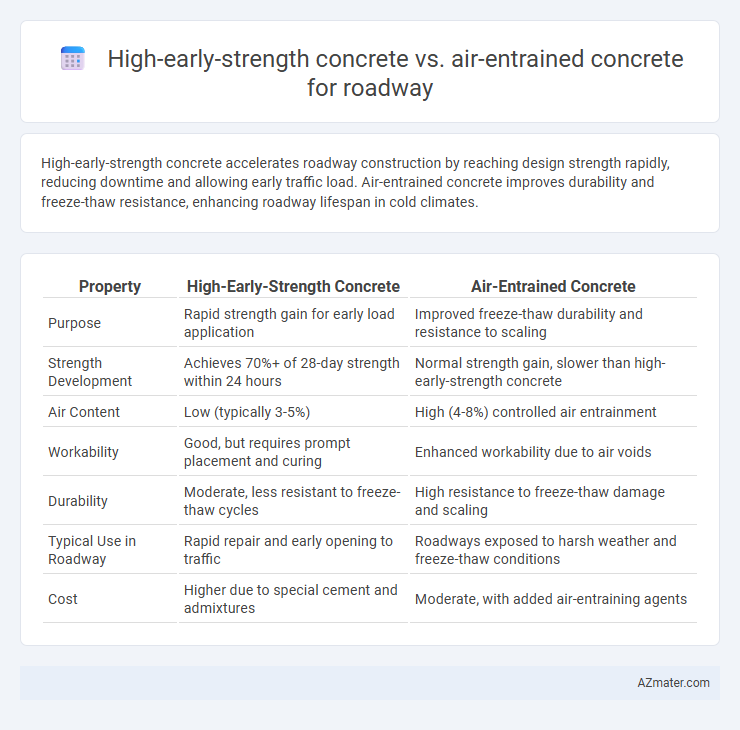High-early-strength concrete accelerates roadway construction by reaching design strength rapidly, reducing downtime and allowing early traffic load. Air-entrained concrete improves durability and freeze-thaw resistance, enhancing roadway lifespan in cold climates.
Table of Comparison
| Property | High-Early-Strength Concrete | Air-Entrained Concrete |
|---|---|---|
| Purpose | Rapid strength gain for early load application | Improved freeze-thaw durability and resistance to scaling |
| Strength Development | Achieves 70%+ of 28-day strength within 24 hours | Normal strength gain, slower than high-early-strength concrete |
| Air Content | Low (typically 3-5%) | High (4-8%) controlled air entrainment |
| Workability | Good, but requires prompt placement and curing | Enhanced workability due to air voids |
| Durability | Moderate, less resistant to freeze-thaw cycles | High resistance to freeze-thaw damage and scaling |
| Typical Use in Roadway | Rapid repair and early opening to traffic | Roadways exposed to harsh weather and freeze-thaw conditions |
| Cost | Higher due to special cement and admixtures | Moderate, with added air-entraining agents |
Introduction to Concrete Types for Roadways
High-early-strength concrete achieves rapid strength gain, enabling quicker road reopening and reducing traffic disruption, making it ideal for fast-paced construction projects. Air-entrained concrete enhances durability and resistance to freeze-thaw cycles by incorporating microscopic air bubbles, which improves pavement longevity in cold climates. Selecting between these types depends on project timelines and environmental conditions, optimizing roadway performance and maintenance costs.
Defining High-Early-Strength Concrete
High-early-strength concrete is designed to achieve compressive strengths of 3,000 psi or higher within the first 24 hours, enabling rapid construction and early load-bearing capacity for roadways. This concrete type uses a higher cement content and often incorporates accelerators to shorten setting time and increase early strength gain. In contrast to air-entrained concrete, which improves freeze-thaw durability by introducing microscopic air bubbles, high-early-strength concrete prioritizes speed of strength development over frost resistance.
Understanding Air-Entrained Concrete
Air-entrained concrete contains microscopic air bubbles that improve freeze-thaw durability and resistance to scaling, making it ideal for highway pavements exposed to harsh weather conditions. This type of concrete enhances workability and reduces water demand, promoting longer pavement life by minimizing surface cracking and spalling caused by water expansion during freezing cycles. Unlike high-early-strength concrete, which gains strength rapidly for quick traffic opening, air-entrained concrete prioritizes durability and longevity in cold climates.
Key Differences in Composition
High-early-strength concrete incorporates calcium sulfoaluminate or high-dose cement to accelerate hydration and achieve rapid strength gain within 24 hours, while air-entrained concrete contains microscopic air bubbles created by air-entraining agents like vinsol resin to improve freeze-thaw durability. The key difference lies in composition: high-early-strength mixes have increased cementitious material and chemical accelerators, whereas air-entrained mixes include surfactants that incorporate uniform air voids of typically 5-8%. These compositional changes directly affect performance attributes--high-early-strength concrete supports faster construction schedules, while air-entrained concrete enhances resistance to cyclic freezing and thawing in roadway pavements.
Performance Under Load and Traffic
High-early-strength concrete achieves rapid strength gain, allowing roads to support traffic loads sooner, which minimizes downtime and expedites construction schedules. Air-entrained concrete incorporates microscopic air bubbles that enhance durability by improving resistance to freeze-thaw cycles and de-icing chemicals, crucial for long-term performance under traffic stress. While high-early-strength concrete excels in early load-bearing capacity, air-entrained concrete offers superior durability and longevity for roadways exposed to heavy traffic and harsh environmental conditions.
Durability in Various Climates
High-early-strength concrete provides rapid strength gain essential for quick roadway reopening but may have reduced freeze-thaw durability compared to air-entrained concrete. Air-entrained concrete incorporates microscopic air bubbles, enhancing resistance to freeze-thaw cycles and deicing chemicals, making it more suitable for cold and wet climates. Selecting the appropriate concrete type depends on balancing early load-bearing requirements with long-term durability needs in specific environmental conditions.
Construction Time and Curing Requirements
High-early-strength concrete significantly reduces construction time by achieving compressive strengths of 3,000 psi or more within 24 hours, allowing for faster traffic reopening and minimizing road closure duration. Air-entrained concrete, while improving freeze-thaw durability essential for roadway longevity, requires standard curing times of 7 to 28 days to reach design strength, extending the overall construction schedule. Proper curing conditions are critical for both types, but high-early-strength mixes often need controlled temperature environments to optimize rapid strength gain, whereas air-entrained concrete demands consistent moisture retention to maintain entrained air void stability.
Cost Implications and Economic Factors
High-early-strength concrete accelerates project timelines by reducing curing periods, leading to significant labor and equipment cost savings in roadway construction. Air-entrained concrete enhances durability and resistance to freeze-thaw cycles, lowering long-term maintenance expenses but typically incurs higher upfront material costs due to admixtures. Selecting between these concretes involves balancing initial investment against lifecycle economic benefits, where highway agencies prioritize fast reopening with high-early-strength mixes or prioritize longevity with air-entrained formulations.
Suitability for Different Roadway Applications
High-early-strength concrete is ideal for rapid construction and repair of roadways, allowing traffic to resume quickly due to its accelerated curing time and early load-bearing capacity. Air-entrained concrete is preferred for roadways exposed to freezing and thawing cycles, as the entrained air bubbles improve durability by reducing freeze-thaw damage and scaling. Selecting between these concretes depends on project priorities: early strength and fast turnaround favor high-early-strength concrete, while long-term durability in cold climates necessitates air-entrained concrete.
Summary: Choosing the Right Concrete for Your Roadway
High-early-strength concrete is ideal for roadways requiring rapid construction and early load-bearing capacity, reducing downtime and traffic disruption. Air-entrained concrete enhances durability by improving resistance to freeze-thaw cycles and de-icing chemicals, crucial for colder climates. Selecting the right concrete depends on project timelines, environmental conditions, and long-term performance needs.

Infographic: High-early-strength concrete vs Air-entrained concrete for Roadway
 azmater.com
azmater.com